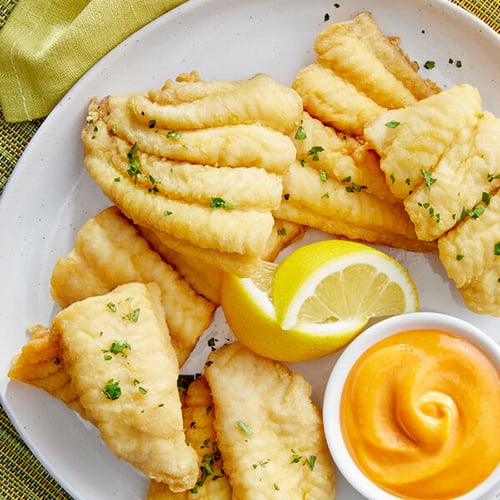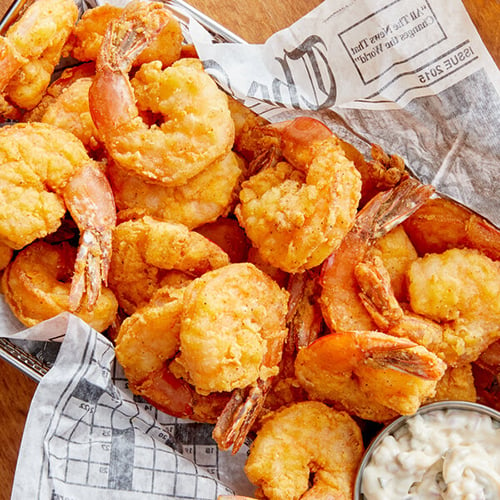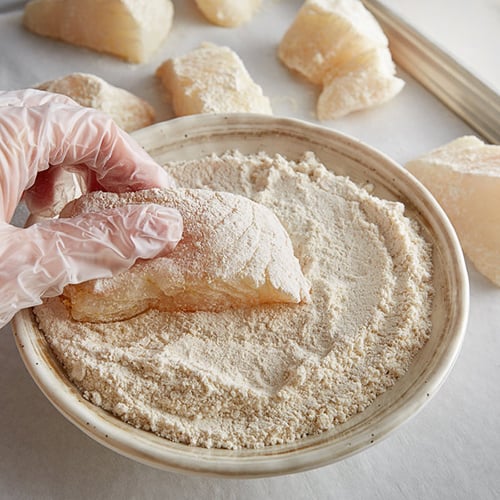Best Oil to Fry Fish
Thanks to its neutral flavor, affordable price, and high smoke point, canola oil is the most popular oil for frying fish. Peanut, cottonseed, and coconut oil are also great fish frying oils. Keep reading to discover the benefits of each oil you can use to fry fish. We also offer fish frying tips, so you can cook your fish fillets to perfection every time.
Shop All Fryer OilBest Oil for Deep Frying Fish

To help you select the best oil for your fish fry, discover the top oils for deep frying fish, their smoke points, and their benefits below:
1. Canola Oil
Canola oil has a high smoke point and a neutral flavor. Rich in omega-3 and omega-6 fatty acids, canola oil is a comparatively healthful choice for frying fish. It is also relatively affordable.
- Canola Oil Smoke Point: 400 degrees Fahrenheit
2. Peanut Oil
Peanut oil is affordable, and it has a neutral flavor that won't affect the flavor of your fish. It also prevents flavor transfer. Unfortunately, peanut oil contains one of the big 8 food allergens, which limits the number of guests who can enjoy your fried fish.
- Peanut Oil Smoke Point: 450 degrees Fahrenheit
3. Cottonseed Oil
Cottonseed oil has a high smoke point. It's also affordable, making it an excellent option for establishments that are frying in bulk and need to stock up on oil.
- Cottonseed Oil Smoke Point: 450 degrees Fahrenheit
4. Coconut Oil
Coconut oil is the healthiest option for deep frying your fish. It has a neutral taste and reduces flavor transfer between batches. However, coconut oil is a less economical choice.
- Coconut Oil Smoke Point: 450 degrees Fahrenheit
Oil for Frying Fish
The type of oil that you deep fry your fish in impacts how it fries, its taste, and its texture, so it's important that you choose the right oil for the task. Here are three major things you need to consider when choosing oil for frying fish:
- The Smoke Point - The smoke point is the temperature when oil starts to break down and become unusable. When deep frying fish, you want to use an oil that has a high smoke point so you can fry the fish at a high temperature.
- The Flavor - Fish is delicate, so you want to choose an oil with a neutral flavor that won't overpower the fish.
- Flavor Transfer - If you're frying different types of seafood (or other foods) simultaneously, you must prevent the flavors from transferring.
Best Fish to Fry

Not every type of fish is suitable for deep frying. When choosing a fish to deep fry, look for an option that has a neutral flavor and isn't too oily. Typically, neutral flavored, white-fleshed, and lean fish are best for frying. Freshwater fish such as bass, trout, and catfish are excellent choices. Avoid dense and oily tuna, salmon, and sea bass.
Here are some of the best types of fish to fry:
Frying Fish FAQ
Now that you know the best oil to deep fry fish with and which type of fish you should fry, you’re ready to prepare your own fish fry. Below, we answer some of the most frequently asked questions chefs encounter when frying fish.
Oil Temp for Frying Fish
Your fish frying oil temperature should range between 350 and 375 degrees Fahrenheit. The fish needs to reach a safe internal temperature of 140 to 145 degrees Fahrenheit before it is finished frying.
How Long to Fry Fish
As a general rule, you should deep fry small batches of fish for 3 to 6 minutes. You must adjust the time based on the type of fish you’re deep frying; you will need to fry your fish fillets longer than your oysters. How long you fry fish also depends on the temperature of your oil.
How to Fry Fish with Flour and Egg

Use our fried fish taco recipe to learn how to fry fish with flour and egg. It’s a simple process of creating a batter, dipping the fish into the batter, adding the fish to your fryer unit, frying it until it turns a beautiful, golden brown, and then cooling it on a parchment-lined rack.
How to Make Egg Wash for Frying Fish
Follow these simple steps to make an egg wash for frying 1 pound of fish:
- Crack 3 eggs into a bowl
- Add six tablespoons of whole milk
- Beat to combine the milk and eggs
Deep Fried Fish Temperature
Deep fry your fish at temperatures between 350 and 375 degrees Fahrenheit. If the temperature is above 380 degrees Fahrenheit, it will scorch the fish. If it's below 360 degrees Fahrenheit, the batter may absorb too much oil, creating a greasy mouthfeel.
How to Prep Fish for Frying
Prep fish for frying by following these simple steps:
- Brine the fish
- Create an egg wash
- Season the fish
- Dip the fish in the egg wash
- Dredge the fish in flour
Flour or Egg First When Frying Fish?
Coat fish in an egg wash first, then dredge it in flour. The egg wash will help the flour stick to the fish. Coating fish in egg and flour before frying it creates a crispy outer crust around the delicate, flakey protein. This flour shell also helps contain the protein’s juices and adds rich flavor.
What to Soak Fish in before Frying
Soaking fish in a 6 percent salt brine before frying it firms the fish, causing it to hold up better in the fryer. The salt in the brine enhances the flavor and keeps the meat from drying out.
Selecting the right oil can ensure flavors don't transfer, the fish doesn't become greasy, and the seafood’s natural taste isn’t overpowered. Use our guide to analyze every factor that affects how your fish fries, including the best oils for frying fish, how to prepare fish for frying, and the best fish to fry.
Related Resources

How to Host a Seafood Boil at a Brewery
If you own a brewery or brewpub, hosting a seafood boil is a great way to bring your local community together while also increasing sales at your business. One of the best additions to any seafood boil is delicious, ice cold beer, so hosting an event like this will draw in new customers and give them a chance to try out some of your signature brews. The ingredients and preparation methods for different types of seafood boils vary by region, but the delicious results are always the same. Keep reading to learn more about preparing for and hosting a successful seafood boil party at your brewery. What is a Seafood Boil? Generally speaking, a seafood boil refers to a social event or gathering that centers around the preparation and consumption of shellfish. The contents and cooking styles of seafood boils vary by region, along with the side dishes and drinks served. Seafood boil parties are often sponsored by community organizations or seafood restaurants, making them the perfect opportunity to socialize with friends while enjoying delicious food. However, a brewery is also an ideal place to hold a boil, especially if you plan on cooking with or serving beer at your event. In terms of ingredients, seafood boils include shellfish like whole crabs, crab legs, lobster, clams, mussels, shrimp, and crawfish. These ingredients will vary based upon the area of the country where the boil is held and which seafood is in season. You may also want to include vegetables like onions, celery, potatoes, and corn, and spices like bay leaves, garlic, salt, pepper, chilies, and thyme. Some seafood boils even include andouille sausage for an extra burst of flavor. What Are the Different Kinds of Seafood Boils? The preparation style and ingredients in seafood boils vary by what's available and prevalent in specific regions of the country and that area's unique culinary history. Keep reading to learn more about different seafood boil party menus. Cajun and Louisiana Seafood Boils Cajun and Louisiana-style seafood boils are synonymous and typically only feature one type of seafood -- usually shrimp, crab, or crawfish. If you decide to hold this kind of seafood boil party, you might also want to add andouille sausage and Cajun seasonings, like cumin, coriander, and paprika. You can also purchase pre-mixed Cajun seasoning mixes. Historically, this style of seafood boil has been held in the French Quarter area of New Orleans since at least the 1950s. Georgia and South Carolina Lowcountry Seafood Boils Lowcountry seafood boils usually feature a variety of different seafood and are generally less spicy than their Cajun cousins. The finished product is often called Frogmore Stew, which refers to a town in the fishing community of St. Helena Island in South Carolina. Seafood boil parties in this area have been held since the 1960s and showcase the region's rich melting pot of French, Spanish, African, and Caribbean flavors. If you're holding this style of seafood boil, you might also consider adding ham, another traditional ingredient in Lowcountry boils. Chesapeake and Mid-Atlantic Crab Boils Seafood boils in the mid-Atlantic region are largely centered around crabs, which are plentiful in the Chesapeake Bay and nearby Atlantic Ocean. The crabs at a crab boil party are typically steamed or boiled in spiced water or beer. Afterwards, the crabs are seasoned with seafood spice mixes like Old Bay or J.O., both of which complement and showcase the flavor of the crab. Guests will then crack, pick, and eat the crab meat by hand alongside dipping sauces and sides like corn and cole slaw. New England Seafood Boils When holding a New England seafood boil, you'll want to have plenty of clams and lobster on hand. Most locals also add potatoes, corn, and mild sausage to the mix, and seasoning is minimal. New England seafood boils are the perfect choice for breweries, because the most common boiling liquid is beer. How Can You Market and Spread Awareness for Your Seafood Boil? Effectively marketing your seafood boil is crucial to its success. We spoke with Anthony at Old Ox Brewery in Ashburn, VA, who held a seafood boil to benefit autism awareness in collaboration with Ford's Fish Shack, a local restaurant that provided seafood for the event. He offered the following pro tips on how they successfully marketed their boil: "Some of our channels included listing the event early on our website (at least 30 days prior to the event), email marketing, having the staff talk to patrons about it, having table toppers and posters advertising it, and reaching out to every possible local news outlet we could... I believe we ended up getting listed on around 10 websites (between calendars and actual news coverage like the Loudoun Times-Mirror)." "Ford's Fish Shack and Autism Speaks helped as well. Lastly, and probably most importantly, we promoted through Facebook and Facebook ads. We were posting pictures on our main Old Ox page and on the event page itself... Every time someone likes a picture that we post, the reach for that post increases substantially, so we posted a lot and it worked extremely well for this event. We use Facebook and social media heavily to promote all of our events, big or small." Can You Hold a Seafood Boil if Your Brewery Doesn't Serve Food? While many breweries also have kitchens that serve a variety of delicious foods, some are solely focused on their beer. If your brewery doesn't serve food, you can hire a catering company and bring them on site to prepare your seafood boil. Be sure to obtain any necessary special event licenses beforehand, as you don't want to be held liable if guests are injured, become sick, or choose to drink and drive. Why Use Beer to Boil Your Seafood? While some people use water as their primary boiling liquid, beer is an excellent choice for cooking at a seafood boil. The natural sugars and maltiness inherent in beer will add a rich depth of flavor to your food. Beer also helps tenderize meats and seafood. You'll probably want to use a mild ale or lager, as these brews will add flavor without interfering or clashing with the flavor of the food. We also spoke with Fort Collins Brewery in Fort Collins, CO. They had the following to say about using beer as your primary boiling liquid: "We paired [our seafood boil] with Major Tom's Pomegranate Wheat. We also boiled the shrimp using that beer. We did this because that particular beer pairs very well with seafood dishes. The sweetness and tartness helps bring out the savory flavors of the boil." Which Beers Should You Serve to Complement Your Seafood? The style of beer you serve at your seafood or crab boil party depends largely upon the type of shellfish you'll be serving. For recommended pairings, check out our list below: Clams - German pilsners like Victory Brewing Company's Prima Pils Crabs - Farmhouse saisons like Brewery Ommegang's Hennepin Crawfish - American pale ales like Lagunitas Brewing Company's A Little Sumpin' Sumpin' Ale Lobster - Hefeweizens like Sierra Nevada's Kellerweis Mussels - A Berliner weiss like Firestone Walker Brewing Company's Bretta Rose Oysters - English stouts like Magic Hat Brewing Company's Heart of Darkness Shrimp - Doppelbocks like Brauerei Ayinger's Celebrator If you're interested in pairing your beer with other ingredients in the boil, here are a few suggestions. Corn - Lagers like Guinness's Harp Lager Potatoes - Amber ales like Tröegs Brewing Company's Nugget Nectar Sausage - A märzen like Spaten-Franziskaner-Bräu's Oktoberfestbier Ur-Märzen Should You Brew A Unique Batch of Beer for Your Seafood Boil? If you'd like to provide a more personal touch at your seafood boil (and expose more patrons to what your brewery has to offer), you can brew a unique batch of beer specifically for the event. Old Ox did this for their boil, and it was a huge hit. Here's what they had to say about this signature brew: "We brewed a hybrid-style beer (blending an ale and lager together) and named it "Blue Lobstah." We collaborated with the team from Ford's Seafood Shack on this beer... We created several different varieties for them to try, and they loved the hybrid, so we named it and ran with it!" "Here was our description of the beer: 'Our special event beer is "Blue Lobstah!" This hybrid style blends the crisp, refreshing base of a golden lager with the subtle spice complexity of a farmhouse ale.'" What Equipment Do You Need to Host a Seafood Boil? The most important piece of equipment you'll need at your seafood boil party is an outdoor gas stove, in addition to a large stock pot and stock pot basket. You can also purchase a steamer kit, which will generally contain a stock pot, steamer basket, propane burner, and other accessories. You'll also want to have a large mesh scoop to ladle the seafood, meat, and vegetables out of the stock pot. If you're more of a traditionalist, you can substitute a net or wire mesh for the stock pot basket. What Else Will You Need on the Day of Your Seafood Boil? Weather permitting, the best place to hold your seafood boil is outside on your business's lawn, patio, or deck. Instead of spreading tablecloths, lay down several layers of newspaper or heavy weight brown paper. When your boil is ready, you can drain the extra water onto the ground and dump the food directly onto the tables. Be sure to provide plenty of napkins, paper towels, wet wipes, and wet towels for guests to clean their hands with during and after the boil. Similarly, you might want to have bowls handy for shells and corn cobs. If guests are eating crabs or other hard-to-pick seafood, you'll want to have crab mallets and knives nearby. When it comes to condiments, consider having cocktail sauce, drawn butter, hot sauce, and lemons at every table. You might also want to have crackers or bread available. When patrons finish their feast, all you'll have to do is ball up the paper with the shells and other trash inside and place it in a garbage can. When hosting an event like a seafood boil in your space, it's also important to keep event management supplies on hand, too. If your brewery or brewpub is looking for new ways to bring guests through your doors, hosting a seafood or crab boil party is a great place to start. Depending on what's plentiful in your area, you can choose between a variety of seafood boil styles and ingredients. Similarly, holding a boil gives your business the opportunity to showcase your best beers and pair them with different types of delicious shellfish. With these seafood boil party ideas in mind, grab your shellfish, steam pot, and beer and get boiling!

How to Clean a Deep Fryer
Choosing the right oil for your fryer is only part of what makes fried food delicious. Keeping your deep fryer clean and your oil fresh can have a huge impact on the flavor of your appetizers and entrees. We’ll guide you through the step-by-step process of cleaning a deep fryer, including draining and filtering the oil, boiling out the fryer, and disposing of spent grease. By following these simple steps, you can keep your deep fryer in optimal condition and continue to serve delicious fried dishes to your customers. Shop All Fryer Cleaner Click on any of the links below to skip to the fryer maintenance process you need: How to Boil Out a Deep Fryer How to Filter Fryer Oil How to Dispose of Fryer Oil How to Boil Out a Deep Fryer Boiling out a deep fryer is the process of removing old oil, adding water and cleaning solution, and then boiling the water to thoroughly clean the interior of the fryer and remove any hard, stuck-on grime. Follow the steps in the video below to boil out your fryer: <iframe scrolling="no" src="/v/?num=8505&width=600&height=500&embed=1" frameborder="0" height="500" width="600" style="user-select: auto;"></iframe> Fryer Boiling Out Instructions Drain all of the grease from the fryer and safely discard it via an oil caddy and an approved oil discharge container. Use a fryer cleaning rod to clean any remaining debris out of the drain line. Rinse the fryer with hot water to remove excess undrained fat. Fill the fryer with cool water within at least 3-4" of the top. Then, add your deep-fat fryer cleaner. Check the instructions on the bottle to find the specific amount you need to use. Boil slowly for 20 minutes. Turn off the fryer and allow the soapy water to cool down. Allow the fryer to drain slowly. When the water has drained, use a long-handled fryer brush to clean the sides, top, and heating elements of the fryer. Rinse thoroughly to remove all residue. Add your new oil. Add fry powder or oil stabilizer to the fresh oil to make it last longer. Why Should I Boil Out My Deep Fryer? There are a few benefits to regularly boiling out your commercial deep fryer: Reduce Flavor Transfer: Boiling out your deep fryer is an essential step to prevent flavor transfer between different food items. Over time, oils and fats can absorb the flavors of the foods being cooked, resulting in an undesirable taste in subsequent batches. Boiling out the fryer helps remove any residual flavors, ensuring that each batch of fried food maintains its original taste. Prolong the Oil's Lifespan: Regularly boiling out your deep fryer can significantly extend the lifespan of the frying oil. As oil is used for frying, it accumulates food particles, debris, and other impurities that can negatively impact its quality. These impurities can cause the oil to break down faster, resulting in a shorter oil lifespan. Boiling out the fryer helps remove these impurities, keeping the oil cleaner for longer and reducing the need for frequent oil changes. Reduce Chemicals Needed to Fight Build-up: When a deep fryer is not properly cleaned, a build-up of carbon deposits, grease, and food particles can occur. This build-up can be challenging to remove and may require the use of strong chemical cleaners. Boiling out the fryer regularly helps prevent excessive build-up, reducing the need for harsh chemicals to break it down. By reducing the reliance on chemicals, you can create a safer and more environmentally friendly cleaning routine for your deep fryer. How Often Should You Boil Out a Fryer? To keep your fryer in optimal condition, it is recommended to boil out the fryer at least once a week. This helps to maintain its efficiency and ensure the quality of your fried foods. You may need to boil out your unit more frequently depending on how heavily your unit is being used. Follow the manufacturer’s manual for the specific cleaning instructions. How to Filter Fryer Oil Filtering fryer oil is an essential step in maintaining the quality and longevity of your fryer. Regularly filtering your fryer oil not only helps remove impurities and extend its lifespan but also ensures that your fried foods consistently turn out crisp and delicious. Invest in a reliable fryer oil filter machine or a filtering system specifically designed for commercial fryers. These machines are equipped with filters that capture even the smallest impurities, ensuring cleaner oil for your frying needs. <iframe scrolling="no" src="/v/?num=10185&width=600&height=500&embed=1" frameborder="0" height="500" width="600" style="user-select: auto;"></iframe> Fryer Oil Filtering Instructions Make sure to allow the oil to cool down to a safe handling temperature before starting the filtering process. Hot oil can cause severe burns, so it's crucial to exercise caution and wear appropriate protective gear. Start by positioning the filter machine near the fryer, ensuring it is stable and secure. Place the filter paper or screen inside the machine, following the manufacturer's instructions. Carefully pour the cooled oil into the filter machine's reservoir, allowing it to pass through the filter and into a holding container or back into the fryer. If filtered into a holding container, you can take the opportunity to clean the fryer thoroughly by boiling it out. Remove any remaining food particles or debris from the fryer's interior, using a fryer brush or other appropriate cleaning tools. Return the filtered oil to the fryer with the basin or connection hose. After filtering, properly dispose of the collected waste, which may include food particles, crumbs, and other debris. Follow local regulations and guidelines for the safe disposal of used fryer oil waste. How Often Should You Filter Fryer Oil? Aim to filter your fryer oil at least once a day, or more frequently if your fryer sees heavy use. Regular filtering helps remove food particles, crumbs, and other debris that can accumulate and affect the oil's quality. Can I Leave Oil in My Deep Fryer? While it is best to store oil outside of your fryer when it is not in use for long periods of time, you can leave oil in your deep fryer for short periods. That being said, it is important to first filter the oil to ensure that any food debris does not spoil while in the fryer. Additionally, you should always keep your fryer covered and cool when it is not in use because light and heat are two of the major factors in oil spoiling. Ideally, you should store your oil in a cool, dark place. Storing filtered oil in an airtight container that does not let in light can help extend the life of your oil and save you money. How to Dispose of Fryer Oil Properly disposing of fryer oil is essential for maintaining a clean and safe commercial kitchen. Here are several options for disposing of fryer oil: Hire a Grease Collection Service: Consider hiring a professional grease collection service to handle the disposal of your used fryer oil. These services specialize in collecting and recycling used cooking oil, ensuring that it is disposed of in an environmentally friendly manner. They often provide containers for oil storage and can schedule regular pickups according to your kitchen's needs. Trash It Appropriately: If you are unable to hire a grease collection service, you can dispose of small amounts of fryer oil in the trash. Transfer it to a sealable, leak-proof container, such as a plastic jug or bottle. Label the container as "used cooking oil" to prevent any accidental mishaps. Let it cool and solidify before placing the container in a sturdy garbage bag. Tie it securely before placing it in the trash. Recycle or Donate It: Another eco-friendly option is to recycle or donate your used fryer oil. Some recycling centers accept used cooking oil and convert it into biodiesel fuel. Biodiesel is a renewable energy source that can power vehicles and machinery. Additionally, some local farms or animal shelters may be interested in collecting your used oil for animal feed or other purposes. Contact your local recycling center or nearby farms to inquire about their acceptance policies. Do Not Pour Down the Drain: It is crucial to never pour fryer oil down the drain. Oil can solidify and clog pipes, leading to costly plumbing issues. Additionally, it can harm the environment by contaminating water sources. Always opt for one of the above disposal methods instead. How Often Should You Dispose of Fryer Oil? Over time, fryer oil can become degraded and less effective at frying. The frequency at which you should dispose of the oil will depend on several factors, including the type of food you are frying and the volume of oil you are using. One indication that it's time to dispose of the oil is if it smokes at lower temperatures than before. Additionally, if the oil has become darker in color, has an off-putting smell, or has a thick and foamy surface, it is likely time to dispose of it. Properly disposing of used fryer oil not only ensures the taste and quality of your fried foods but also helps to maintain the longevity of your fryer. Back to Top Proper cleaning and maintenance of a fryer is crucial for ensuring the efficiency of your kitchen equipment. Regularly removing oil, debris, and carbon buildup helps to prevent flavor transfer and maintain the quality of fried foods. By incorporating these cleaning practices into your routine, you can extend the lifespan of your fryer and continue to produce delicious, crispy fried foods for your commercial establishment. Still having trouble with your fryer? Check out our Pitco fryer troubleshooting guide.

Sustainable Seafood for Restaurants
Whether it’s related to food sourcing or disposal methods, sustainability has been at the forefront of foodservice trends and concerns in recent years. One of the primary focuses of the sustainability movement is the health of our oceans and marine life. Over 50% of American consumers identified that sustainable seafood is important to them and that they would pay more for it to help the environment. If your seafood restaurant is looking for greener practices, we’ve collected some seafood sustainability tips that your business can incorporate into your menu this year. Shop All Seafood Click any of the links below to learn more about the sustainable seafood: Sustainability Defined Most Popular Seafood Unsustainable Fishing Methods How to Serve a Sustainable Seafood Benefits of Offering Sustainable Seafood What Is Sustainable Seafood? Sustainable seafood is any fish or shellfish that is caught for consumption in a way that doesn’t threaten its ecosystem or the stability of the species. The way the fish is raised, harvested, or wild-caught must be renewable and cannot jeopardize the future population of that particular species. The fishing method also cannot over-pollute the environment in which the species lives. Popular Seafood Seafood is a great source of Omega-3 fatty acids, vitamins A, B, and D, which makes it a staple on various menus around the world. Even with the nutritional benefits, most Americans only enjoy 5-10 varieties of seafood, which can lead to overfishing of those species and unsustainable harvesting practices. Below are the most popular seafood varieties consumed by the global population: Salmon Shrimp Tuna Crab Alaskan Pollock Tilapia Clams Unsustainable Fishing Practices Fish are harvested for foodservice markets using two distinct methods: wild caught fishing and aquaculture. Both methods can have negative impacts on the environment if not regulated and improved. Without instilling sustainable practices, fisheries are expected to collapse as early as 2050. It is important to take these practices under consideration when selecting seafood types and suppliers for your restaurant. Wild Caught Fishing Wild caught fishing can easily turn unsustainable when companies are overfishing and producing bycatch on their fishing lines and nets. Keep reading for more information on how wild caught fishing can damage the environment and how it can be made more sustainable. Overfishing - Overfishing occurs when mature fish are collected from the ocean faster than the population can reproduce. This can lead to the extinction of a wildly occurring fish population and put pressure on fish hatcheries to make up for the loss to keep up with demand. Bycatch - The term bycatch classifies marine life that is unintentionally caught on fishing lines and in fishing nets along with the target species. Bycatch may include dolphins, sea turtles, sharks, other fish species, and even the wrong size of the target species. If bycatch is not removed from the nets, the animals can die, making open-sea fishing unsustainable to the environment. Wild caught fishing produces about 7 million tons of bycatch a year, with most of a fisherman's catch being bycatch instead of the target fish. Ghost Nets - Ghost nets are fishing nets that are either lost or left behind by fishing boats. The nets continue to trap and entangle sea creatures as they float in the ocean, causing unnecessary loss of life. It is estimated that there are currently 640,000 tons of ghost fishing nets polluting our oceans. Can Wild-Caught Fish Be Sustainable? Although wild caught fishing can be damaging to the ecosystem, there are actions fishermen can take to make the practice more sustainable. To reduce overfishing, fishing companies can follow organizations that research and regulate fish populations to learn which species they should avoid in that season or location. To reduce bycatch, fishing companies can choose selective fishing practices like harpooning, hook and line fishing, and certain traps over bottom trawls and long lines. To reduce ghost nets, fishing companies should try to keep track of their fishing nets and attempt to retrieve them if they come loose. They can also choose fishing gear contact information and tag identifiers so that they can be traced back to the owner if lost. Ocean cleanup organizations also work hard to remove ghost nets from the ocean and recycle them. Aquaculture (Farm-Raised Fish) While many believe that farmed fish provide the most eco-friendly seafood option, this is not always true. Although aquaculture is a great way to boost fish supplies, it can turn unsustainable quickly if not done correctly. Waste - Farm-raised fish produce a considerable amount of waste, including uneaten feed and excrement that can build up in their enclosures or pollute the habitat in which they are raised. This can lead to increased nitrogen levels, toxic algae blooms, and disease in the fish population if not filtered correctly. Chemical Usage - Some aquacultures use certain chemical hormones as growth enhancers, like methyltestosterone, that increase the size and growth rate of a fish population. This changes the genetics of the fish and can have harmful effects on humans, like liver toxicity, when the fish is consumed. Unsustainable Feed Ingredients - If aquaculture farmers are using wild-caught forage fish to feed their farm-raised fish, then they are depleting the population from the natural ecosystem and causing other species to suffer. If aquaculture fish are put on an entirely plant-based diet, then fisheries must consider the carbon footprint caused by land farming. Containment Issues - Fish that are raised in an aquaculture system are genetically different from those in the wild. If a farm-raised fish escapes from its enclosure, it can end up reproducing and mutating the wild population, which will upset the natural ecosystem. Can Farm-Raised Fish Be Sustainable? With some modifications and effort, fish farms can become a sustainable option for the future of seafood. To reduce waste pollution, companies should take advantage of natural filtration methods like using seaweed and bivalves to reduce the waste that is able to run downstream. They should also implement thorough filtration and waste disposal plans for their facility. To reduce chemical usage, fish farms should use biosecurity management methods and early diagnosis to detect changes and diseases in the fish population. They should also avoid using antibiotics as a grown enhancer that can mutate the genetics of the fish. To reduce the use of unsustainable feed ingredients, fish farmers can switch to natural and balanced fish feed made with microalgae, seaweed, insects, microbes, nuts, and some forage fish. To reduce containment issues, companies keep their fish separate from the wild ecosystem, by using secure enclosures and regularly checking their enclosures and nets for damage. Back to Top How to Run a Sustainable Seafood Restaurant Most customers will associate locally sourced products with sustainability, but that isn't always the case for fish and other seafood. Seafood sustainability comes down to how the fish was raised and harvested, along with the proximity of the water source. We’ve prepared a list of actions you can take to ensure that your seafood restaurant works towards becoming a more sustainable business. Through sourcing and menu changes, you can reduce your impact on our oceans. 1. Look For Sustainable Suppliers When choosing a supplier for your seafood restaurant, you’ll want to pick one that prioritizes sustainability with its product. To narrow down your choices, ask suppliers the following questions to ensure that they are taking the appropriate measure to provide eco-friendly seafood options: Are they part of a trusted sustainability certification program? What is their preferred fishing method? What sustainability practices are they using in that method? If wild-caught, how do they reduce bycatch? What research are they doing to choose which species and location to target without greatly impacting the fish population? If farm-raised, what do they feed their fish? How do they treat disease? How do they handle the waste that is produced? What are their sustainability goals and how can you help them achieve those goals? You’ll want to select a supplier who is transparent about their fishing practices and sustainability goals, and one that is familiar with current fishing policies so you can in turn serve your customers environmentally friendly seafood options. You can also look up fishers and suppliers on ocean advocate websites to see how they rank. 2. Make Menu Changes A major factor in becoming a restaurant with sustainable seafood is making menu changes. Choosing seafood options that are less in demand than traditional selections is a great way to reduce your environmental impact. Below are some ways that you can make your seafood menu more environmentally friendly: Serve Trash Fish Invasive and unpopular fish species, also known as “trash fish”, provide a great alternative to species like salmon, tuna, and swordfish that are being overfished. Here are some trash fish alternatives you can choose that would still be delicious on a menu: Pollock Triggerfish Lionfish Sheepshead Fish Sea Robin Whiting Mackerel Anchovies Sardines Serve Seasonal Fish Just like vegetables have a growing season, fish populations also fluctuate with seasons and location. The sites Seafood Watch and FishWatch.gov can give you an understanding of which species are thriving during the current season and which are depleted based on your region so you can easily make sustainable menu adjustments. For example, the Pacific salmon season begins in the spring on the West Coast. Striped bass is in abundance on the East Coast during the summer, while albacore tuna is in season during the summer on the West Coast. Peconic bay scallop season begins in the fall on the East Coast and winter is a great time for Dungeness crabs on the West Coast. Serve Vegan Alternatives You can expand your seafood menu by offering seafood options that aren't made with fish at all. If you’re looking to become vegan-friendly or make more sustainable choices, vegan seafood is a great substitute for your restaurant. Vegan seafood is made to imitate the look, taste, and texture of fish by using all plant-based ingredients. You can find vegan salmon and tuna sashimi, shrimp, and calamari made with natural ingredients like tapioca starch and kelp or seaweed extract. 3. Check for Fish Certification Labels When Shopping When looking for high-quality and sustainable stock for your seafood restaurant, it's important to look for sustainable seafood certifications on packaging or display cases. Eco-certified seafood labels mean that the product was raised or caught in eco-friendly and sustainable conditions that meet the standards required by the certification. You can list these logos on your menu next to certified ingredients as a selling point for customers. Keep reading to become familiar with the leading seafood certifications in the foodservice industry. Sustainable Seafood Certifications The following are some of the top sustainable fish certifications to look for when picking seafood products for your restaurant. ASC Certified - The Aquaculture Stewardship Council certification provides strict guidelines for farm-raised seafood that are socially and environmentally responsible. GLOBALG.A.P. Certified - The Global Good Agricultural Practices certification has strict criteria for animal welfare, legal compliance, environmental care, and supply chain transparency in aquaculture settings. RSPCA Assured - The assured certification by the Royal Society for the Prevention of Cruelty to Animals indicates that a salmon or trout product was raised in aquaculture according to their high standards for animal welfare and humane treatment. Quality Trout UK Assured - The assured certification by Quality Trout UK guarantees that a trout product was raised and harvested following the high standards of the program to ensure humane treatment in trout aquaculture settings. Friend of the Sea Certified - The Friend of the Sea certification ensures that fisheries and aquaculture upheld the proper treatment of a species and used responsible fishing practices to protect natural resources. Marine Stewardship Council Certified - The Marine Stewardship Council certification provides benchmarks for wild-caught fisheries to meet that ensure their catch is traceable and sustainable. You can find some seafood products that do not fall under a particular sustainable certification, but rather are broadly recognized as eco-friendly alternatives, including muscles, clams, and kelp. These options are used for their restorative aquacultural effects on marine ecosystems, such as providing natural water filtration. By adding them to your menu, your business helps support sustainable efforts indirectly. 4. Work with Your Neighbors to Find Sustainable Options If you’re striving to take steps towards offering sustainable seafood, it can be very helpful to ask your neighboring restaurant owners for advice and potentially work together to reach a common goal. Here are some seafood sustainability questions you can ask other restaurants: Do they use sustainable seafood suppliers? Which suppliers? Are they part of any sustainable seafood organizations or fishery programs? Would they be interested in joining together to reach purchase volumes with sustainable suppliers? Are they familiar with any additional actions you could take or local organizations you can join to reach your sustainability goal? 5. Share Your Efforts with Your Customers As food trends progress, it is clear that customers are attracted to sustainable choices. Approximately 50% of consumers say they will support sustainable seafood options if they are available, and they are even willing to pay more for them. A great way to boost your sustainability efforts is by being open and transparent with your customers about your menu choices and suppliers. By listing a menu option as “sustainably sourced seafood”, customers will be more likely to order it and help you boost your bottom line to continue financing your sustainable goals. Train your servers to be able to answer questions on where and how your fish and seafood options were sourced and what efforts your business is taking to be more environmentally friendly to our oceans. List the sustainable certifications of your ingredients to help your customers easily identify eco-friendly meal options. Benefits of Serving Sustainable Seafood Offering sustainable seafood in your restaurant can bring positive impacts to your business and the environment. Here are some of the benefits of serving sustainable fish on your menu: Customers are looking for sustainable choices and will pay more for them Decreased pollution on land and in the oceans Healthier fish population in the oceans to support the food chain Reduced risk of species extinction Back to Top By choosing sustainable options for your restaurant, you can be part of the movement to provide a safer and healthier planet for generations to come. Use this guide to incorporate sustainable seafood in your recipes and support ocean health with your business.
